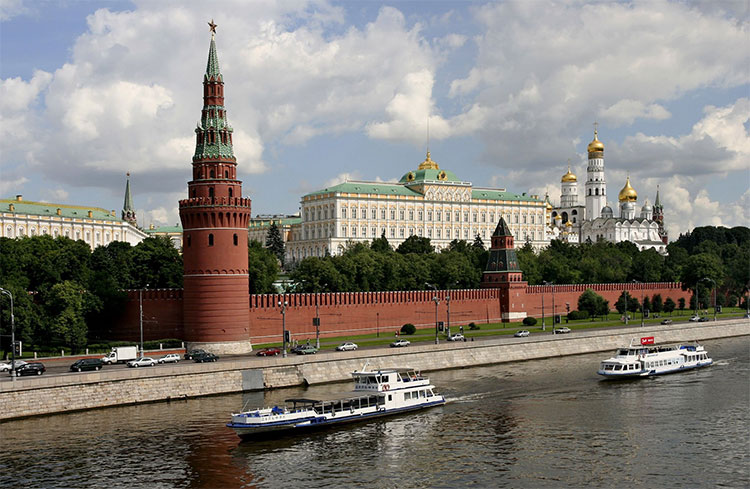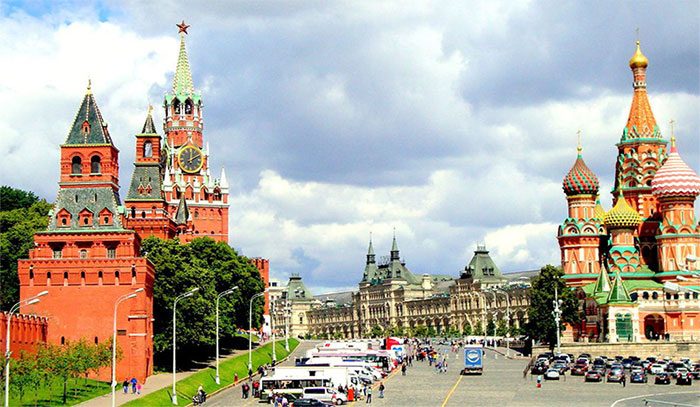Secrets behind the Kremlin door
- which symbolizes Russian history - is largely designed by Italian architects Leonardo da Vinci at the same time.
For eight centuries, the Kremlin has witnessed many ups and downs of Russian history. This stronghold has particularly ancient structures, including the sacred Dormition church dating back to 1479. The paved square around this building is a frequent destination for most visitors. The area also includes two other churches, a 16th-century bell tower and a palace that looks like a giant, Independent jewel.

Over time, the fortress has repeatedly stood on the verge of collapse due to Mongol attacks and civil wars, but Moscow's princes have always known how to stand firm and gradually strengthen their capabilities.(Photo: En.Wiki).
Founded in the 12th century, this fortress originally consisted of a series of castles and wooden churches located on a hill between two rivers. Its resilience not only lies in ugly clay wooden walls, but also in a remote location in the middle of a dense primeval forest.
When the Mongolian empire began to collapse in the 15th century, the stronghold in Moscow became a place of military dominance in the region.
The Kremlin of the present begins to be formed from this point. Built on the orders of Prince Ivan III, this castle is not based on local techniques. The symbol of the future of Russia is designed by contemporary Italians with Leonardo da Vinci.

The red square is right next to the Kremlin.(Photo: Onthegotours).
For 50 years, beginning in the 1470s, these foreigners have turned Ivan's faded stronghold into an architectural masterpiece. They started with the Dormition Church, which had to be designed in accordance with the rules and beliefs of Orthodoxism.
The Italians designed the Kremlin's core and walls, but the towers of electricity were not completed until later. Because important records have been lost, it is surmised that the author of the famous Tower of Salvation (clock tower) may be an Englishman. At the end of the 17th century, the civil war in Russia destroyed half of the castle and made the construction of unfinished parts.
Under the new reign of the Romanovs, the Kremlin became a bloody fortress with brutal purges. The tsar (Russian lords) had to rely on James I and craftsmen from the British Isles to help Russia refurbish the castle. Perhaps no one knew who built the tower, but the clock on the tower was definitely designed by a Scottish.

Art deco details were brought, Italian-style walls surrounding the fortress were built, as well as a series of low-rise buildings linked by elevated paths that made it a lavish labyrinth. .(Photo: Onthegotours).
The Russian value in this structure was somewhat overwhelmed by foreign designs until the 1840s, when the Big Kremlin was built for Nicholas I. This was a project designed by a Russian architect and himself. Also built on the Armory Chamber (Armory Chamber) - the place where the museum of Russian royal treasures is located.
These large structures occupy a large part of the southwestern corner of the Kremlin today. The Presidential building, with its highly visible arched roof, is a neoclassical masterpiece designed in the 1770s. Although famous for its spectacular gardens, artistic statues, or gourd halls sex, this is not a place to visit.
In modern times, this historic building only undergoes renovation projects instead of new ones. The most recent attempt was made during the Boris Yeltsin period (the 90s of the last century), when he ordered the removal of an entire area that used to be the dining and bathing areas to rebuild the Red Staircase. These covered terraces - which used to let ancient lords descend from their palaces - signify Russia's rebirth.
- Russia has a lot of Kremlin, not just Moscow, as you might think
- Kremlin
- Secrets of the Sun Door
- Revealing the secrets of fake doors in the tomb of Pharaoh
- Kremlin and Red Square
- How to use safe rolling door
- Why do passengers always have to get on or off the plane by the door on the left?
- Key points of the car door lock system
- Is it possible to open the plane when flying?
- Fun stories about the Kremlin race
- It turned out that the revolving door was invented for this very interesting reason
- Egypt found the door to the afterlife
 'Fine laughs' - Scary and painful torture in ancient times
'Fine laughs' - Scary and painful torture in ancient times The sequence of numbers 142857 of the Egyptian pyramids is known as the strangest number in the world - Why?
The sequence of numbers 142857 of the Egyptian pyramids is known as the strangest number in the world - Why? Miracle behind the world's largest stone Buddha statue
Miracle behind the world's largest stone Buddha statue What is alum?
What is alum?